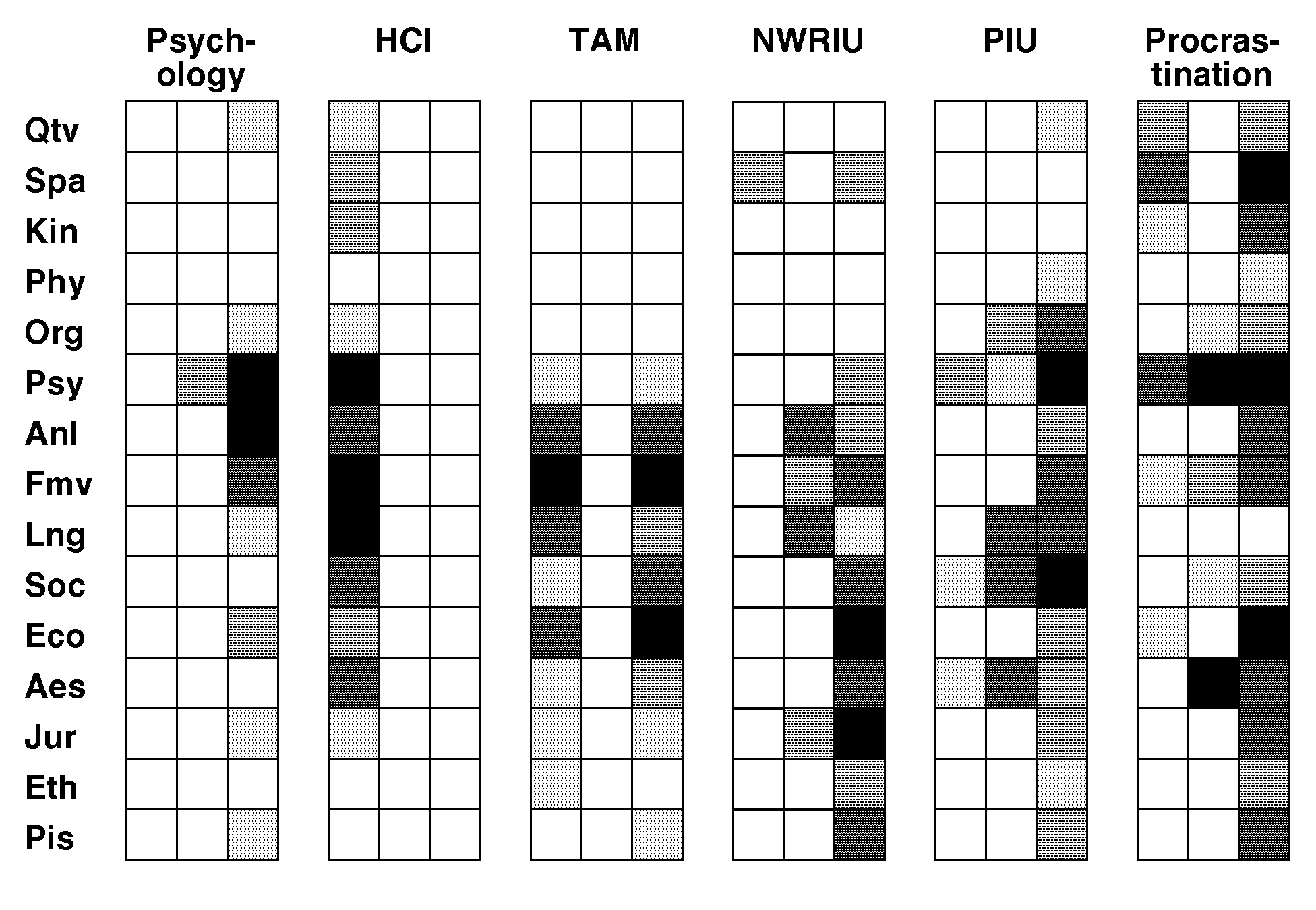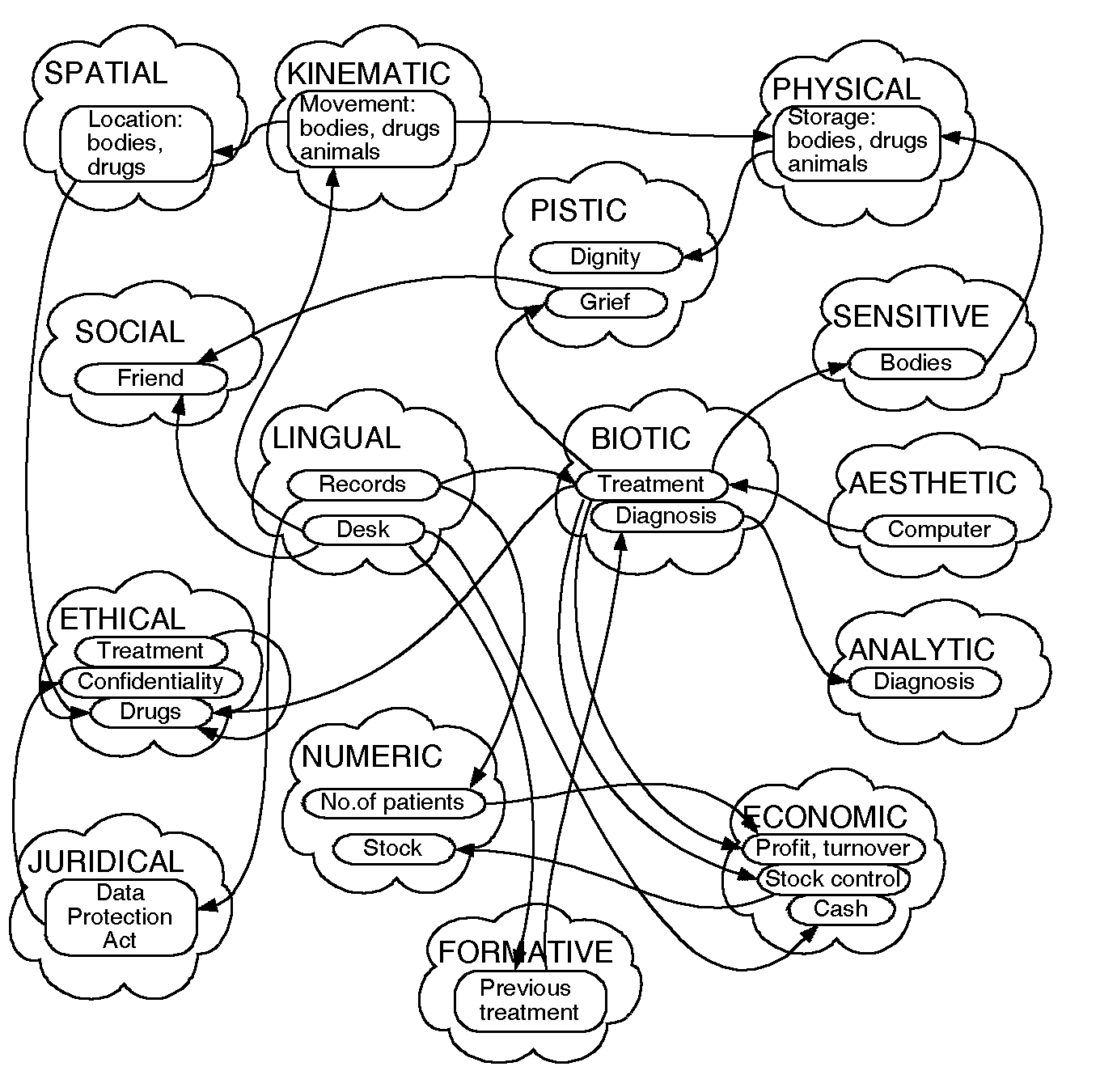
In all four, Dooyeweerd's suite of aspects may be used as a checklist. Even though Dooyeweerd's suite of aspects exceeds most others (including, for instance, Maslow's Hierarchy of Needs), as discussed in Comparison of Suites, the researcher should still treat it critically and recognise it is only a 'best guess' about the diversity of reality, rather than any final truth.
The fundamental idea behind using Dooyeweerd's aspects in these ways is that reality functions in all aspects simultaneously, that every aspect is, in principle, important, and hence if any aspects are omitted from consideration during research, a priori, then our research will be deficient and its findings are likely to be distorted.
Normally, Dooyeweerd's aspects would be used to understand the ways in which the main topics discussed in the literature are meaningful. Doing this can reveal over-emphasis and under-emphasis in the literature of the field and, especially, whole areas of interest that have been ignored.
Two ways of doing this have been pioneered by Breems [2014] and Joneidy [2015]. Both read the literature of the field and identified which aspects make the most important issues of the discourse meaningful. For example, in the field of psychology, the sensitive (psychical) aspect is centrally important, and the biotic of bodily functions can often be important. Individual papers, however, might find other aspects meaningful, such as the lingual aspect in the psychology of language use.
Their method, and its variations, can be useful in understanding the literature of a field. The basic method is to identify the main aspects that are important in each discourse by analysing the literature of each. Usually different discourses find different sets of aspects important. Plotting the aspects of all the discourses can reveal aspects to which too little attention has been given, and thus gaps in the literature of the field. This provides sound philosophical justification for new research trying to fill those gaps.
They took a slightly different approach. Joneidy analysed individual seminal papers that initiated various discourses, in two fields of information systems use [Joneidy & Basden 2018] and health care informatics [Joneidy & Burke 2018]. Joneidy was specifically looking for what motivated each seminal papers from excerpts from their introductions, conclusions, etc. and identified which aspect(s) made each motivation meaningful. A similarly systematic approach could be employed to understand major issues that are important in each paper. He set his results out in a table like:
| Aspect | Paper 1 | Paper 2 | Paper 3 | Paper 4 | Paper 5 | Paper 6 |
|---|---|---|---|---|---|---|
| Quantitative | * | |||||
| Spatial | ||||||
| Kinematic | ||||||
| Physical | ||||||
| Biotic / Organic | ||||||
| Psychic / Sensitive | ||||||
| Analytical | * | |||||
| Formative | * | * | ||||
| Lingual | * | |||||
| Social | * | * | ||||
| Economic | * | * | ||||
| Aesthetic | * | |||||
| Juridical | * | |||||
| Ethical | * | |||||
| Pistic / Faith | * |
As can be seen, many aspects are of interest in more than one paper, but some in only one paper. Those are, perhaps, the aspects that demand further research. The early aspects are often missing because they are deemed only to serve or enable other aspects.
Breems took a broader but less systematic approach to understanding why no discourse has adequately researched computer procrastination. Reading a range of papers in each, he noted down issues therein, and identified which aspects made them meaningful. He also identified in which of three functionings the issue was meaningful (engaging with the computer, engaging with meaningful content, and engaging in their lives). He judged, from the frequency and strength of issues in each aspect of each engagement, how important that aspect was and generated 'heatmap' diagrams like Figure 1. This shows what interest five different discourses take in the various aspects of the three engagements, the darker, the more interest, and also from empirical study of computer procrastination itself. It can be seen that none of the discourses are interested in all the aspects of all engagements that are important in understanding computer procrastination.

Figure 1. Breems' Heatmap Diagrams, which show the aspectual interest of discourses, compared with empirical activity in computer procrastination (right-hand map).
In such ways, papers may be systematically analysed by aspect and the results of such analyses presented.
This shows the Model is focused heavily on the formative aspect, but recognises the psychical reality of perception and attitude, and the need to measure. Therefore TAM would not be an appropriate model to use in research that is interested in the lingual, aesthetic, social or any other aspect.
In such ways, aspectual analysis of the contents of any conceptual framework can reveal the range and limits of its applicability.
One response to such critique is to propose a version of a concpeptual framework in which missing aspects are incorporated. For example, juridical, ethical and pistic aspects could be added to TAM, to cover the impact of regulations, attitudes and prevailing beliefs.
Two methods were employed. One is to ask interviewees to identify meaningful issues and ask them which aspect(s) they believe makes them meaningful. This is carried out step-by-step, with the interviewee asked to identify a couple of main aspects of their expertise first (e.g. biotic and economic for vetinerary practice), then asking for issues, then more issues, and gradually, as issues build up, which aspects make each meaningful. This stimulates the interviewees to think of related issues, and thus other aspects, many of which might have been taken for granted.
Winfield would plot their issues and aspects of a large sheet of paper, and ask the interviewees to link issues together in any way they wished. Figure 2 shows a simple diagram resulting from Winfield's Multi-aspectual Knowledge Elicitation (MAKE) method.

Figure 2. A MAKE diagram for vetinerary practice, showing issues and aspects of expertise. Copyright (c) Michael Winfield 2000, used with permission.
Kane took a similar approach with some students, but found that it was only suited to those who were used to conceptual thinking. For those less used to conceptual thinking, she found that interviewees preferred to go through the aspects one by one (in any order they wished) to think of their aspirations, etc. Aspiration was thus revealed to be a complex, multi-aspectual thing, for example a person might be motivated by family issues, financial issues as well as desire to learn (social, economic, lingual/analytical aspects).
These are only two possible ways of using Dooyeweerd's aspects during interviewing, and readers might forge other methods. But both Kane and Winfield found that:
Ahmad [2014], Khojah [2018] and Aiyenitaju [2018] pioneered a method of doing this, and thereby were able to study the 'down-to-earth' issues that are meaningful to people 'on the ground' in everyday situations of work or life, as opposed to the 'high level' issues that are of interest to managers, academics or sales people.
They would take excerpts from interview transcripts and analyse each phrase, and sometimes, word, to find which aspects made them meaningful to the interviewee. For example:
Question: If you have more things to do at one time, how do you handle the pressure?Answer: I know I have work to complete [Formative] and it is my responsibility [Juridical] so I'll do it. I will do it by priority [Analytical], which one needs to be completed first [Juridical]. Then at a later stage I will do the rest [Formative].
In this short explanation, analytic, formative and juridical aspects are meaningful.
This can yield a considerable amount of data, meaningful in many aspects, which can then be analysed either quantitatively or qualitatively or both. For instance, Khojah studied the use of health care records in hospitals, and found a profile of interest in aspects among the health care workers, shown in Figure 3.
![Aspectual profile of Relative importance of each aspect (%) in work with healthcare record. (688,975]](../pix/aspect.profile.gif)
Figure 3. Aspectual profile: Relative importance of each aspect (%) in work with healthcare record.
This can stimulate investigation of why certain aspects are more and others are less meaningful. In this way, cultural and contextual issues can be brought to the surface.
Dooyeweerd's aspects are very useful because they are (a) comprehensive in their coverage, (b) intuitive to grasp, (c) irreducible to each other, (d) yet related to each other in ways that are fairly well understood.
Use of Dooyeweerd's aspects in research calls for further development and refinement in the light of experience. Researchers are invited to employ them and then publish the results of doing so, so that all may learn.
A much fuller collection of experience in using Dooyeweerd in research will be found in Chapter 11 in Basden [2019].
Ahmad H, Basden A. 2013. Down-to-Earth Issues in Information System Use. Proceedings of the Pacific Area Conference on Information Systems (PACIS). Paper 191.
Ahmad H. 2013. Down-to-earth Issues in the Mandatory Use of Information Systems
Aiyenitaju OT, Basden A. 2017. ICT in the classroom: A study of diverse aspects. UK Academy for Information Systems (UKAIS) Annual Conference, 4-5 April 2017, University of Oxford, UK.
Aiyenitaju OT. 2018. Understanding Classroom Issues Encountered by Teachers: The Application of Dooyeweerd's Philosophy. PhD Thesis, University of Salford, Salford, UK.
Basden A. 2008. Philosophical Frameworks for Understanding Information Systems. IGI Global Hershey, PA, USA.
Basden A. 2011a. Enabling a Kleinian integration of interpretivist and critical-social IS research: The contribution of Dooyeweerd's philosophy. European Journal of Information Systems. 20, 477-489.
Basden A. 2011b. A Presentation of Herman Dooyeweerd's Aspects of Temporal Reality. International Journal of Multi-aspectual Practice, 1(1), available at "http://dooy.info/papers/ijmap/issue1/Basden-Aspects.docx".
Basden A. 2018. Foundations of Information Systems: Research and Practice. Routledge, London, UK.
Basden A. 2019. Foundations and Practice of Research : Adventures with Dooyeweerd's Philosophy. Routledge, London, UK.
Breems N. 2014. The Human Use of Computers Framework: Assessment Using the Computer Procrastination Problem. PhD. Thesis, University of Salford, Salford, UK.
Breems N. 2017. Subject-by-proxy: A tool for reasoning about programmer responsibility in artificial agents. Ethicomp, 5-8 June 2017, De Montfort University, U.K.
Breems N, Basden A. 2014. Understanding of computers and procrastination: A philosophical approach. Computers in Human Behavior, 31(2014), 211-223.
Kane SC. 2006. Multi-aspectual Interview Technique (MAIT). Doctoral Thesis, University of Salford, Salford, U.K.
Eriksson D. 2003. Identification of normative sources for systems thinking: inquiry into religious ground-motives for systems thinking paradigms. Sys. Res. and Behavioral Science. 20(6), 475-87.
Khojah GM. 2013. A new approach to the transition from paper to electronic medical records. Pp. 277-283 in D. Stacey, J. Solé-Casais, H. Gamboa, HEALTHINF 2013: Proceedings of the International Conference on Health Informatics, 11-14 February 2013, Barcelona, Spain.
Khojah GM. 2018. Using Dooyeweerd's Aspects to Understand Down-to-Earth Issues in Use of Medical Records. PhD Thesis, University of Salford, Salford, UK.
Winfield MJ. 2000. Multi-Aspectual Knowledge Elicitation. PhD Thesis, University of Salford, UK.
Winfield MJ, Basden A, Cresswell I. 1996. Knowledge elicitation using a multi-modal approach. World Futures, 47, 93-101.
Winfield MJ, Basden A. 2006. Elicitation of highly interdisciplinary knowledge. pp. 63-78 in S. Strijbos, A. Basden (eds.) In Search of an Integrated Vision for Technology; Interdisciplinary Studies in Information Systems. Springer.
This page, "dooy.info/using/aspects.in.resch.html", is part of a collection that discusses application of Herman Dooyeweerd's ideas, within The Dooyeweerd Pages, which explain, explore and discuss Dooyeweerd's interesting philosophy. Email questions or comments are welcome.
Written on the Amiga and Protext in the style of classic HTML.
You may use this material subject to conditions. Compiled by Andrew Basden.
Created: 10-21 May 2019. Last updated: